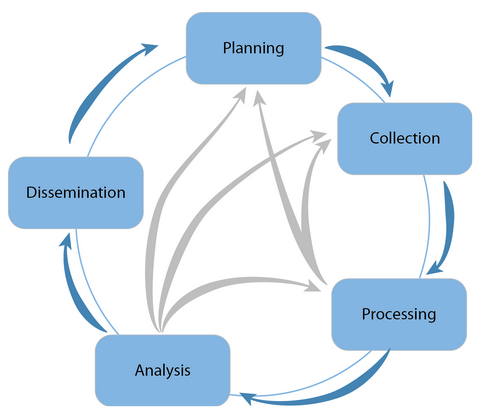While this course is academic in nature, it will use the intelligence process and its components as a framework to help introduce the importance of cultural geographical concepts to human security and intelligence analysis. Throughout the course, we will refer back to some of these components to help aid in your understanding of where cultural geography may be most helpful and applicable within the Intelligence Process Framework.
Intelligence Analysis Process Components
There are five major components to the intelligence analysis process. While a variety of different terms are used to describe each component, generally they are: planning, collection, processing, analysis, and dissemination.
The planning component of the process often begins with some request for information or a need. Once that need has been expressed, a plan to complete the request is devised. This plan may include analytic techniques required and collection strategies to collect the information needed to conduct the analysis.
The collection component deals with the gathering of information. This information can often be gathered from a number of different intelligence sources. In this course, we’ll mostly be focusing on GEOINT (geospatial intelligence), but there are a variety of different intelligence disciplines for places from which information can be derived, including OSINT (open source intelligence) and HUMINT (human intelligence) (Clark, 2011).
The processing component is where analysts take the results from your collections strategies, which is often raw information, and create usable information. An example of this is exploiting imagery, translating an article, or evaluating information for its reliability (Intelligence Careers, n.d.).
The analysis component takes the information that results from the processing component and synthesizes this information to formulate assessments and judgements.
Finally, the dissemination component is where the results of the analysis are put into a form that is conveyed to customers. While this can take a variety of forms, we’ll introduce you to one form of dissemination: the written brief.
Comparison with Academic Research Process
In many classes, the intelligence process is referred to as a cycle, similar to the research process or cycle. In fact, if you put the two side by side, they in many ways mirror each other. In Figure 2.1, we can see that many of the components of the “intelligence cycle” mirror that of the research cycle. Both often begin with planning and designing. In research you need to figure out how to manage and fund your research, and while this is a concern in the intelligence process, it’s not often included in the process. Collection in the intelligence cycle is part of the “search” phase in the research cycle. “Processing and Exploitation” is also part of the search and analyze process; however, in the intelligence cycle, analysis and exploitation are treated separately. Finally, all of these result in some level of sharing of your research or analysis: “dissemination.”

© Penn State University is licensed under CC BY-NC-SA 4.0
A Cycle? …
The intelligence process is often considered to be a cycle. In many ways it is. It can be initiated by some requirement, resulting in some level of dissemination, which may in turn result in additional taskings and requirements.
But, rarely does the cycle pan out as simply as often conveyed. The same is true of academic research. Rarely are these “cycles” as simple as progressing from one step to the next without having to reassess, recollect data, reanalyze, etc. Each component is related to the next, and, while there is a general progression, there are times when you as a researcher or analyst need to know when to go back to another component to produce the most rigorous analysis possible. You may collect the information and process it, only to find that you need to collect more information. Or, you may make it all the way to the analysis phase and realize you need to collect more information. In fact, you may make it to the analysis phase and realize you need to go back to the planning stage. Much like academic research, intelligence analysis is rarely cut-and-dried. Figure 2.2 depicts the complicated nature of the intelligence process.

Many scholars have discussed the general conceptual issues with the “Intelligence Cycle.” Some scholars, like Hulnick (2006), dissect many of the individual components, raising the issues that may be overlooked by simplifying intelligence with this conceptual diagram. Other researchers seek to move the intelligence framework forward, including research such as Gill and Phythian (2013) who propose a framework that is less like a cycle and more like a web, trying to capture the complicated nature of intelligence analysis. While it is beyond the scope of this class to assess these various frameworks, it is important to know that while the intelligence cycle is an excellent starting point for understanding intelligence analysis, it is an extremely simplified construct.
Optional Readings:
Gill, P. & Phythian, M. (2013). From Intelligence Cycle to web of intelligence: complexity and the conceptualization of intelligence. In M. Phythian (Ed.), Understanding the Intelligence cycle (pp. 21-42). Taylor & Francis Group.
Hulnick, A. S. (2006). What’s wrong with the Intelligence Cycle. Intelligence and National Security, 21(6), 959-979.
References:
Charles Sturt University Library (2021). For researchers.
Clark, R. M. (2011). The Technical Collection of Intelligence. CQ Press.
Gill, P. & Phythian, M. (2013). From Intelligence Cycle to web of intelligence: complexity and the conceptualization of intelligence. In M. Phythian (Ed.), Understanding the Intelligence cycle (pp. 21-42). Taylor & Francis Group.
Hulnick, A. S. (2006). What’s wrong with the Intelligence Cycle. Intelligence and National Security, 21(6), 959-979.
How Intelligence Works. (n.d.). U.S. Intelligence Careers. Retrieved December 16, 2021, from